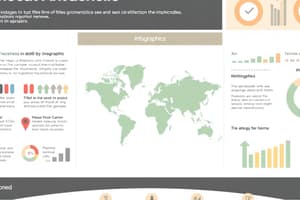Podcast
Questions and Answers
What is an example of a color scheme that uses colors next to each other on the color wheel?
What is an example of a color scheme that uses colors next to each other on the color wheel?
- Complementary
- Monochromatic
- Triadic
- Analogous (correct)
Which color scheme utilizes two colors that are directly opposite each other on the color wheel?
Which color scheme utilizes two colors that are directly opposite each other on the color wheel?
- Complementary (correct)
- Triadic
- Split Complementary
- Monochromatic
What is the primary difference between serif fonts and sans serif fonts?
What is the primary difference between serif fonts and sans serif fonts?
- Sans serif fonts are commonly used in print publications.
- Serif fonts have additional strokes at the ends of letters. (correct)
- Serif fonts are easier to read than sans serif fonts.
- Sans serif fonts tend to have more decorative elements.
Which shape is classified as geometric?
Which shape is classified as geometric?
Which typography style is best suited for small amounts of text such as titles and headers?
Which typography style is best suited for small amounts of text such as titles and headers?
What does the principle of balance refer to in graphic design?
What does the principle of balance refer to in graphic design?
Which of the following color schemes consists of three colors that are evenly spaced around the color wheel?
Which of the following color schemes consists of three colors that are evenly spaced around the color wheel?
Which of the following is NOT a characteristic of geometric shapes?
Which of the following is NOT a characteristic of geometric shapes?
What is the primary purpose of emphasis in design?
What is the primary purpose of emphasis in design?
Which design principle ensures that closely related elements are perceived as one unit?
Which design principle ensures that closely related elements are perceived as one unit?
What does proportion refer to in design?
What does proportion refer to in design?
Which principle of design is primarily concerned with the repetition of visual elements?
Which principle of design is primarily concerned with the repetition of visual elements?
What should be done if the contrast between an image and its background color is not good?
What should be done if the contrast between an image and its background color is not good?
How does alignment contribute to the overall design?
How does alignment contribute to the overall design?
What effect does variety have on design?
What effect does variety have on design?
Why are shadows added to an image in image manipulation?
Why are shadows added to an image in image manipulation?
What is graphic design primarily focused on?
What is graphic design primarily focused on?
Which of the following best describes the aim of visual design?
Which of the following best describes the aim of visual design?
How do lines contribute to graphic design?
How do lines contribute to graphic design?
What effect do warm colors like red, orange, and yellow have in design?
What effect do warm colors like red, orange, and yellow have in design?
Which color is associated with feelings of wisdom and peace?
Which color is associated with feelings of wisdom and peace?
What role do infographics play in communication?
What role do infographics play in communication?
Which of the following is NOT a characteristic of color psychology?
Which of the following is NOT a characteristic of color psychology?
What does a visual designer aim to create across multiple touchpoints?
What does a visual designer aim to create across multiple touchpoints?
What role does the team manager play in a team dynamic?
What role does the team manager play in a team dynamic?
Which function is primarily associated with the editorial manager?
Which function is primarily associated with the editorial manager?
What is the main responsibility of a content curator?
What is the main responsibility of a content curator?
What is the primary purpose of content syndication?
What is the primary purpose of content syndication?
Which of the following best describes the role of an analytics expert?
Which of the following best describes the role of an analytics expert?
What is a key task of the website manager?
What is a key task of the website manager?
How can online collaboration benefit a team?
How can online collaboration benefit a team?
Which statement best defines a platform in the context of ICT?
Which statement best defines a platform in the context of ICT?
What primarily defines a platform in the context of technology?
What primarily defines a platform in the context of technology?
Which of the following is NOT categorized as a platform?
Which of the following is NOT categorized as a platform?
Why is it essential to consider the platform when developing software?
Why is it essential to consider the platform when developing software?
What is an example of an online platform?
What is an example of an online platform?
How do cloud servers function as a platform?
How do cloud servers function as a platform?
Which of the following statements accurately describes a web browser as a platform?
Which of the following statements accurately describes a web browser as a platform?
What role does a gaming system play as a platform?
What role does a gaming system play as a platform?
Which of these is NOT a characteristic of an online platform?
Which of these is NOT a characteristic of an online platform?
What is a primary consequence of running a cryptocurrency mining program at maximum utilization?
What is a primary consequence of running a cryptocurrency mining program at maximum utilization?
During which project management phase are the main goals and potential problems identified?
During which project management phase are the main goals and potential problems identified?
What role does ethics play in web design according to the content?
What role does ethics play in web design according to the content?
Which phase is characterized by the execution of the action plan?
Which phase is characterized by the execution of the action plan?
Why might the action plan in a project management scenario need to be revised?
Why might the action plan in a project management scenario need to be revised?
What is a significant implication of design decisions in web design?
What is a significant implication of design decisions in web design?
What distinguishes project management for ICT content from general project management?
What distinguishes project management for ICT content from general project management?
What is a critical aspect of the planning phase in project management?
What is a critical aspect of the planning phase in project management?
Flashcards
Graphic Design Definition
Graphic Design Definition
Planning and presenting ideas visually and textually.
Visual Design Goal
Visual Design Goal
Improve visual appeal and usability in designs.
Infographic
Infographic
Information graphic; an image combining information and storytelling.
Lines in Design
Lines in Design
Signup and view all the flashcards
Color's Role in Design
Color's Role in Design
Signup and view all the flashcards
Color Psychology
Color Psychology
Signup and view all the flashcards
Warm Colors
Warm Colors
Signup and view all the flashcards
Cool Colors
Cool Colors
Signup and view all the flashcards
Monochromatic Color Scheme
Monochromatic Color Scheme
Signup and view all the flashcards
Analogous Color Scheme
Analogous Color Scheme
Signup and view all the flashcards
Complementary Color Scheme
Complementary Color Scheme
Signup and view all the flashcards
Serif Font
Serif Font
Signup and view all the flashcards
Sans-Serif Font
Sans-Serif Font
Signup and view all the flashcards
Shape (in design)
Shape (in design)
Signup and view all the flashcards
Balance (in design)
Balance (in design)
Signup and view all the flashcards
Typography
Typography
Signup and view all the flashcards
Online Collaboration
Online Collaboration
Signup and view all the flashcards
Team Manager
Team Manager
Signup and view all the flashcards
Editorial Manager
Editorial Manager
Signup and view all the flashcards
Content Curator
Content Curator
Signup and view all the flashcards
Content Syndicator
Content Syndicator
Signup and view all the flashcards
Analytics Expert
Analytics Expert
Signup and view all the flashcards
Website Manager
Website Manager
Signup and view all the flashcards
ICT Platform
ICT Platform
Signup and view all the flashcards
Symmetrical Balance
Symmetrical Balance
Signup and view all the flashcards
Asymmetrical Balance
Asymmetrical Balance
Signup and view all the flashcards
Emphasis
Emphasis
Signup and view all the flashcards
Proximity and Unity
Proximity and Unity
Signup and view all the flashcards
Alignment
Alignment
Signup and view all the flashcards
Pattern and Repetition
Pattern and Repetition
Signup and view all the flashcards
Proportion
Proportion
Signup and view all the flashcards
Variety
Variety
Signup and view all the flashcards
What is a platform in software?
What is a platform in software?
Signup and view all the flashcards
Why are platforms important?
Why are platforms important?
Signup and view all the flashcards
What is an online platform?
What is an online platform?
Signup and view all the flashcards
What are some examples of online platforms?
What are some examples of online platforms?
Signup and view all the flashcards
What do social media platforms do?
What do social media platforms do?
Signup and view all the flashcards
What are cloud servers used for?
What are cloud servers used for?
Signup and view all the flashcards
What is a website building platform?
What is a website building platform?
Signup and view all the flashcards
How do platforms relate to software?
How do platforms relate to software?
Signup and view all the flashcards
Mining Rigs
Mining Rigs
Signup and view all the flashcards
GPU and CPU Strain
GPU and CPU Strain
Signup and view all the flashcards
Web Design Ethics
Web Design Ethics
Signup and view all the flashcards
Web Design Impact
Web Design Impact
Signup and view all the flashcards
ICT Project Initiation
ICT Project Initiation
Signup and view all the flashcards
ICT Project Planning
ICT Project Planning
Signup and view all the flashcards
ICT Project Development & Implementation
ICT Project Development & Implementation
Signup and view all the flashcards
ICT Project Life Cycle
ICT Project Life Cycle
Signup and view all the flashcards
Study Notes
Lesson 1: Graphic and Visual Design
- Graphic design is the art of planning and projecting ideas visually and textually.
- Graphic design communicates ideas through visuals, such as logos, or complex website layouts.
- Visual design improves the aesthetic appeal and usability of a design using images, typography, layout, and color.
- Visual design aims for user experience optimization and increased conversion.
- A visual designer aims for holistic aesthetic consistency across various brand touchpoints. This involves creating a consistent visual language for a brand or product.
Lesson 1: Infographics
- An infographic is a visual representation of information, storytelling, and perceptions used to communicate a message effectively.
- The visual nature of infographics aids comprehension, making messages easily understood.
Lesson 1: Elements of Visual Design - Lines and Color
- Lines can shape details to attract attention.
- Different types of lines - sharp, thick, thin, broken - create distinct impressions.
- Color is a significant element of visual design capable of grabbing attention.
- Combining colors and using color combinations well, can catch the viewer's eyes.
- Warm colors (red, orange, and yellow), are attention-grabbing, whereas cool colors (blue, green, violet, indigo) are softer.
Lesson 1: Color Theory and Psychology
- Colors evoke various emotions and feelings.
- Red is connected to passion, excitement, and love.
- Pink is gentle, reserved, and earthy.
- Purple signifies mystery, nobility, and glamour.
- Blue relates to wisdom, hope, reason, and peace.
- Green represents nature, growth, and freshness.
- Yellow signifies hope, joy but also danger.
- Orange represents warmth, friendliness, and joy.
- White is associated with truth, indifference.
- Black is connected to nobility, mystery, and coldness.
Lesson 1: Color Theory - Color Formulas
- Color formulas (e.g., Analogous, Complementary, Split Complementary, Triadic) describe how colors relate to one another.
- Analogous colors are adjacent on the color wheel.
- Complementary colors are opposite each other on the color wheel.
- Split complementary use the colors on either side of the complement.
- Triadic colors are equally spaced around the color wheel.
Lesson 1: Typography
- Typography is the style or appearance of text.
- Geometric, organic, and free form shapes are fundamental elements in typography.
- Different variations of the typographical style include serif and sans-serif fonts.
- Serifs and sans-serifs fonts styles are different because of serifs, which is a small decorative element that is used to add a touch of personality to the text.
- Sans-serif fonts are often easy to read on screens, tablets, and mobile phones.
- Use combinations of fonts to improve visual appeal.
Lesson 1: Graphics and Layout Principles
- Visual design principles, like balance, emphasis, proximity, repetition, proportion, and variety, affect the overall visual appeal and functionality of a design.
- Balance is the arrangement of elements evenly distributed.
- Emphasis focuses attention on a specific element.
- Proximity places related elements close together.
- Repetition creates a sense of visual unity and rhythm.
- Proportion refers to the relative sizes of different elements.
- Variety adds visual interest and prevents monotony.
Lesson 2: Image Manipulation Techniques
- Image manipulation involves editing and altering images using software and techniques. Manipulating images involves adjusting aspects like color, brightness, contrast, and resizing.
- Background colors should complement the image itself.
- Cropping involves removing unnecessary parts of an image.
- Image resizing is adjusting an image's dimensions.
- Adding images allows for composition integration.
- Adjustment of the contrast and brightness helps to improve the visibility of objects within the image.
Lesson 2: Basic Image Manipulation Techniques
- Changing background and colors helps improve color blending and image clarity.
- Cropping images cuts out unnecessary parts of an image.
- Resizing images changes an image's size to suit a specific place or purpose.
- Adding pictures integrates images to create a more complete effect.
- Changing contrast and brightness affects the color distinction and visibility of image details.
Lesson 3: ICT for Advocacy and Developmental Communication
- ICT for development (ICT4D) uses technology for international development, socioeconomic progress, and human rights issues.
- ICT4D utilizes tools and services to help less privileged members of societies.
- ICT4D employs infrastructure, knowledge capacities, and various platforms to deliver services and enable development.
Lesson 4: Teamwork Dynamics and ICT Content
- Online collaboration tools improve teamwork and task completion remotely.
- Tools such as instant messengers, videoconferencing applications, and email aid in teamwork.
- Team structure and dynamics in ICT are important components for effective project management.
- A team manager, for example, ensures well-defined priorities to maintain a well-structured workflow in the project.
- Other project members include the editorial manager, content curator, content syndicator, analytics expert, and website manager. Each of these contributes a unique skill to the success of an ICT project.
Lesson 5: Website Creation Ethical Considerations
- Website mining is the process of extracting information from websites. Ethical guidelines when creating websites are crucial for responsible website developers to follow.
- Consideration for misuse of collected information must be factored in when designing a website.
Additional Topics:
- Digital Citizenship: Using technology responsibly in today's connected world.
- Project Management Phases: Initiation, Planning, Development, Monitoring, and Closing. (these phases apply to all project types not just IT)
Studying That Suits You
Use AI to generate personalized quizzes and flashcards to suit your learning preferences.




